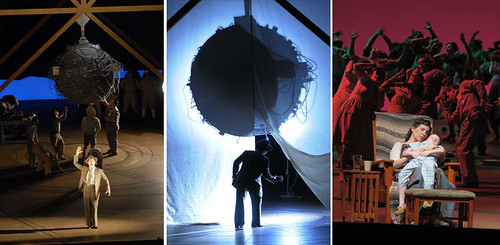An Opera of a Different (And Drearier) Color

The Metropolitan Opera’s new production “Dr. Atomic” is unquestionably one of the most innovative Operas to date. Instead of working with traditional operatic themes such as love and courtship, intrepid composer John Adams tackles a more momentous topic: the Atom Bomb.
Dr. Atomic portrays the final weeks before dropping the atomic bomb on Hiroshima and Nagasaki, Japan in 1945. The geniuses of the country had been assembled to work on this “larger-than-life” project with little or no idea of what the final result would be. Immediately after Germany’s surrender tensions begin to stir and this is where the opera sets in.
It opens with a grand scene of dozens of scientists working in tiny compartments on top of one another – evocative of Japanese capsule hotels. This massive structure of cubicles endures throughout the whole production, and is an extremely impressive demonstration of set designer Julian Crouch’s work. It serves as a projection screen when closed, a laboratory building when split in two, all while being a reference to the scientists’ isolation. Similarly, the bomb that hangs above the stage for the greater part of act II is delicately designed to look like a work of art. Completely spherical and adorned with low hanging wires, it is an idealized version of a bomb; beautiful in only that odd way one could imagine a bomb to be. However, the fantastical set design may be one of the only redeeming aspects of this ambitious production.
Much of the opera is delivered in colloquial prose, which distracts the audience and doesn’t clarify the plot. Opera is considered to be one of those esoteric gems that haven’t well weathered the temperamental changes of time. By choosing to address an issue so recent and modern, Adams has locked himself into an uncomfortable situation of attempting to translate a very serious and historical event to a genre unaccustomed to such depth. The themes of traditional operas are usually light and playful and the audience is able to derive much of their pleasure from the experience of the production rather than from the plot of the libretto. In Dr. Atomic, however, one must listen very closely to the dialog or else resign to not knowing what is going on. Even if the latter is chosen, much of the music seems to be meant to strengthen the guiding plotline, rather than satisfy the audience with the talents of the singers and musicians. So, while there is always a fine line between intellectual thought and art, unless one cares to delve deeply into World War I history, it may be better to stay home and listen to Puccini on MP3.

